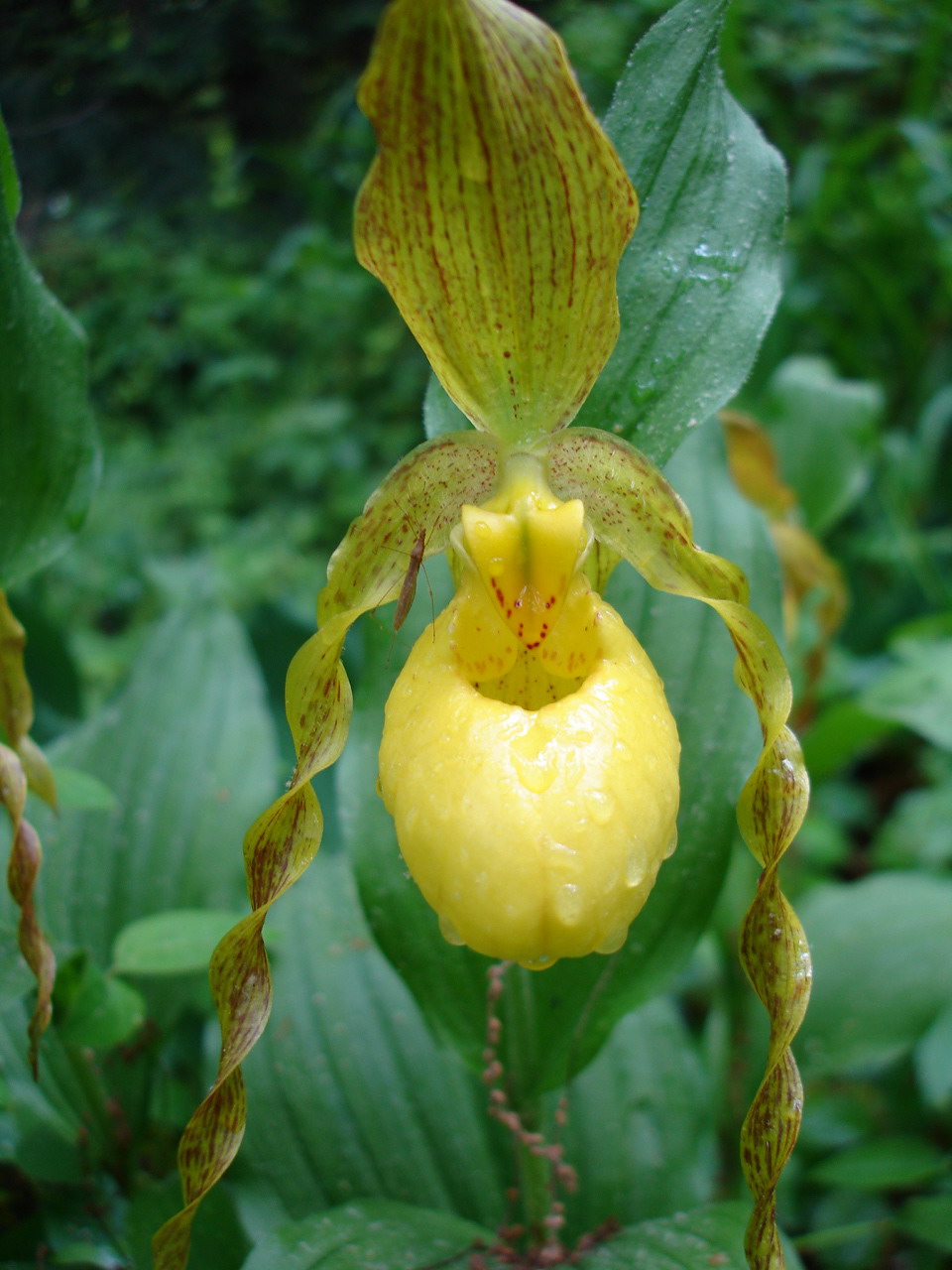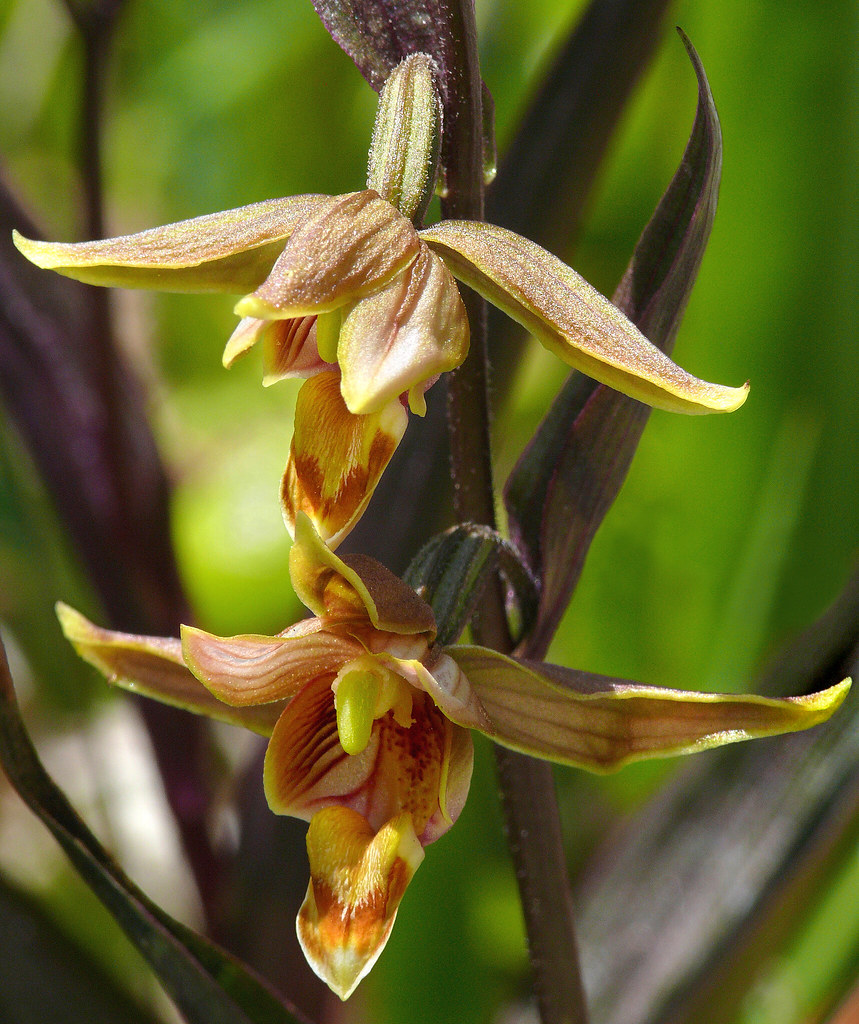Fairyslipper
Calypso bulbosa
Orchidaceae (Orchid Family)
The Fairyslipper orchid is not easily confused with any other Montana plant. Look for it growing low along moist, shady forest floors. Although small-statured, it's a dramatic and striking flower that never fails to elicit a shriek of delight, crumbling my facade of stoic and objective scientific observer. In western Montana, you can usually find them blooming mid-May through June.
The flower is in typical orchid form: three petals and three sepals (which usually look just like petals, so they're called tepals), which are divided into a sort of upper and lower deck. In this case, the lower "lip" petal, known as the labellum, is enlarged, slipperlike, sometimes bearing a yellow throat beard, and covered with a hood. While many orchids grow on a raceme (a long flower stem with many blooms), the fairyslipper grows singly, nodding on a pedicel just a few inches above one elliptical leaf.
Range:
Calypso can be found encircling the globe at northern latitudes--in the western and northern US states, Canada, Scandinavia, Russia and Japan. It grows in deep, moist woodland shade, where there is a thick layer of decaying plant material covering the ground.
What's in a Name?
Calypso was a sea goddess in Greek mythology, who was banished to the island of Ogygia after raising a ruckus with her father, Atlas, during the War of the Titans. She's best known for her role in Homer's Odyssey, in which she imprisons Odysseus on her island. Like the ancient sea goddess, Calypso bulbosa is enchantingly beautiful, and can only be found in secluded haunts. Interestingly, the word "calypso" comes from the Greek kalyptein, "to cover", which is also the root of the word apocalypse (apo- means "away from"; apocalypse = revelation, disclosure).
The word orchid (from the Greek orkhis) literally means "testicle", from the shape of the root of some species. The specific epithet bulbosa is less glamorous; it references the bulb-like corms from which the flower springs.
Tidbits:
We could, of course, go on and on about orchids. They are they most morphologically diverse and highly evolved family of monocots, and contain well over 25,000 species (this is twice the number of bird species in the world, and four times the number of mammals). They occur in every part of the world except Antarctica, inhabiting most any terrain, from rain forests to glaciers.
When I think of orchids, I usually conjure up a steamy cloud forest, with showy flowers clinging to the side of damp trees. These are called epiphytes--plants that grow in the air, attached to another plant, rather than in the soil. It's not a parasitic relationship; they gather moisture and nutrients from the air, falling rain, and occasionally organic debris that accumulates around their perch. Of course, this wouldn't fly in Montana's dry summers. The orchids you find here are called terrestrial orchids, and they're rooted in the earth like any other plant. Folks are surprised to discover that Montana has at least 30 different species of terrestrial orchids, ranging from 3" to over 3 feet tall. Some are unassuming, like the green Bluntleaved Orchid (Platanthera obstusata), others are extremely showy, like the Yellow Ladyslipper (Cypripedium parviflorum-seen above). While you can find many species (like the Hooded Ladies' Tresses, Spiranthes romanzoffiana) quite easily in moist areas, there are others--Giant Helleborine (Epipactis gigantea-below), Sparrow's Egg Ladyslipper (Cypripedium passerinum), Roundleaf Orchid (Platanthera orbiculata)-- that elude all but the most diligent orchid hunter.
Orchids have evolved some of the most fascinating pollination mechanisms on earth. Calypso gives off the scent of nectar, but doesn't actually produce any. When a bee lands on the inflated landing pad of a labellum, it slips down the throat, squirming about in search of the nonexistent food source, then buzzes its pollen-dusted body on to the next trickster flower. Bees are quick to learn and remember this deception; the slight morphological differences in the varieties of Calypso bulbosa may be an adaptation to avoid recognition and extend the ruse.
Wild gardening:
Not recommended. Although Fairyslippers are quite common, they are extremely sensitive to environmental disturbance. They form intricate relationships with soil fungi that are difficult to establish in the home garden. Enjoy them in their natural habitat; it's a good excuse to get out there and see what's blooming.







I’ve tried all sorts of coughing syrups, believe me, but none of them helps. Even though Nin Jiom Pei Pa Koa www.geocities.jp/ninjiom_hong_kong/index_e.htm does not eliminates the cough I like to stick to this chinese syrup I’ve been taking since I was a kid: Nin Jiom Pei Pa Koa. My grandfather is chinese, so I guess my mom got the advice from him. I was really surprised when I found that chinese market selling it here in Belgium. It does have a refreshing, soothing, sweetening effect…as long as it lasts…then back to coughing mode.
ReplyDelete